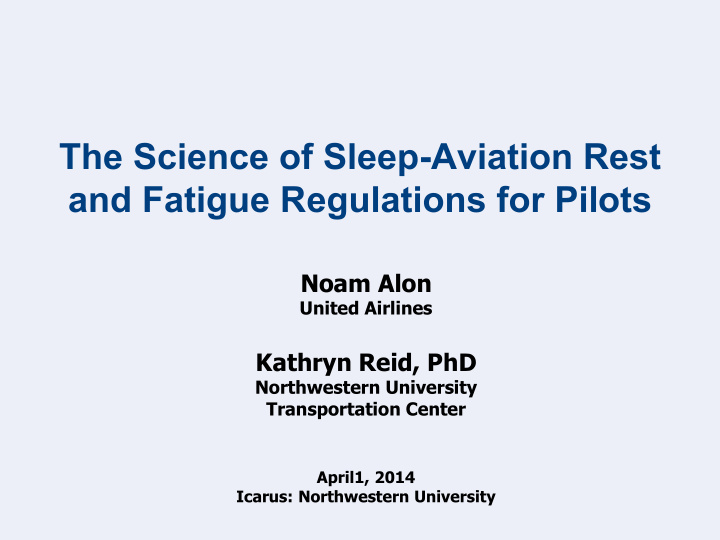



The Science of Sleep-Aviation Rest and Fatigue Regulations for Pilots Noam Alon United Airlines Kathryn Reid, PhD Northwestern University Transportation Center April1, 2014 Icarus: Northwestern University
Agenda • Sleep science • Rationale for the rule • Key elements of FAR 117 • Q/A Adapted from and recognition due to Bob Hughes, United Airlines.
The Science of Sleep-Aviation Rest and Fatigue Regulations for Pilots Kathryn Reid, PhD Research Associate Professor of Neurology Associate Director, Sleep and Circadian Rhythm Research Program Northwestern University Feinberg School of Medicine Chicago, IL April1, 2014 Icarus: Northwestern University
Objectives: Why are there RULES? • The sleep science – Impact of Circadian Rhythms – Regulation of sleep-wake – Consequences of sleep loss – Impact of shift work – Impact of Jet lag
Duty hours • Why does the duty hours rule differ by time of day – Daily duty hours 8 or 9 hours • Why is there a cumulative hours rule? – Cumulative duty hours 100 or 1000 hours
Circadian Rhythms Dijk et al., J. Physiol. 1997, 505:851-858 Dijk & Edgar, 1999, Lung Biology in Health & Disease, vol.133
Circadian Timing System Retinal Ganglion cells (blue 460-480 nm) (Temperature, hormones Performance, mood)
Circadian and Homeostatic Regulation of Sleep Melatonin Adapted from Edgar et al. J Neurosci . 1993
How tired is too tired? F A I D
Expressing the performance impairment due one night of sleep loss as a Blood Alcohol Equivalent Mean Relative Vigilance Performance Blood Alcohol Concentration (%BAC) 1.04 1.02 1 0.05 .98 .96 0.08 .94 .92 1 3 5 7 9 11 13 15 17 19 21 23 25 27 29 Hours of Wakefulness Adapted from Dawson & Reid, 1997, Nature Vol 388: 235
Rest Duration • 10 CONSECUTIVE HOURS minimum and may not be reduced. – This rest must provide a minimum of eight uninterrupted hours of sleep opportunity.
Roach, Reid & Dawson, OEM , 2003
Partial Sleep Debt: Impact on Performance Belenky et al, 2003
Onboard Crew Rest Facilities Why do we care? • To sleep well there are several sleep hygiene rules to follow - those related to the sleep environment include: – cool – dark – quiet – Recumbent (lying down)
Further Challenges: Shift work & Jet Lag
Night work •Circadian misalignment makes working at night and sleeping during the day difficult Time of Day (24 h) 20 21 22 23 0 1 2 3 4 5 6 7 8 9 10 11 12 13 14 15 16 17 Day 1 - Day off Sleep Day 2 - Day off Night shift Sleep Day 3 - Night shift 1 Day 4 - Night shift 2 Day 5 - Night shift 3 Day 6 - Night shift 4 Day 7 - Night shift 5 temperature minimum = time when most sleepy
Major complaints of shift workers – sleep disruption – reduced sleep duration & quality – increased fatigue – reduced alertness – reduced performance – increased psycho-social problems – increased health problems – increased risk of accidents
Jet Lag Acclimation & Theater • Jet lag is associated with travel across multiple time zones • Results in misalignment between the internal circadian clock and the external light-dark and sleep-wake cycle • Results in impairment of daytime function, general malaise, or somatic symptoms such as gastrointestinal disturbance within one to two days after travel.
Jet lag: The Cause • Misalignment between the circadian clock and local time Time of Day (24 h) 14 15 16 17 18 19 20 21 22 23 24 1 2 3 4 5 6 7 8 9 10 11 12 13 14 Boston 19 20 21 22 23 24 1 2 3 4 5 6 7 8 9 10 11 12 13 14 15 16 17 18 19 London Boston (at home) London (on arrival) = when I expect to sleep ok ▼= temperature minimum
Travelling East Clock Time in Denver (hours) 16:00 20:00 24:00 04:00 08:00 12:00 16:00 Sleep time in Denver Sleep time in London Light exposure Light exposure Sleep time in London 23:00 03:00 07:00 11:00 15:00 19:00 23:00 Clock Time in London (hours)
Travelling West Clock Time in London (hours) 23:00 03:00 07:00 11:00 15:00 19:00 23:00 Sleep time in London Light exposure Sleep time in Denver 16:00 20:00 24:00 04:00 08:00 12:00 16:00 Clock Time in Denver (hours)
Thank you
Recommend
More recommend